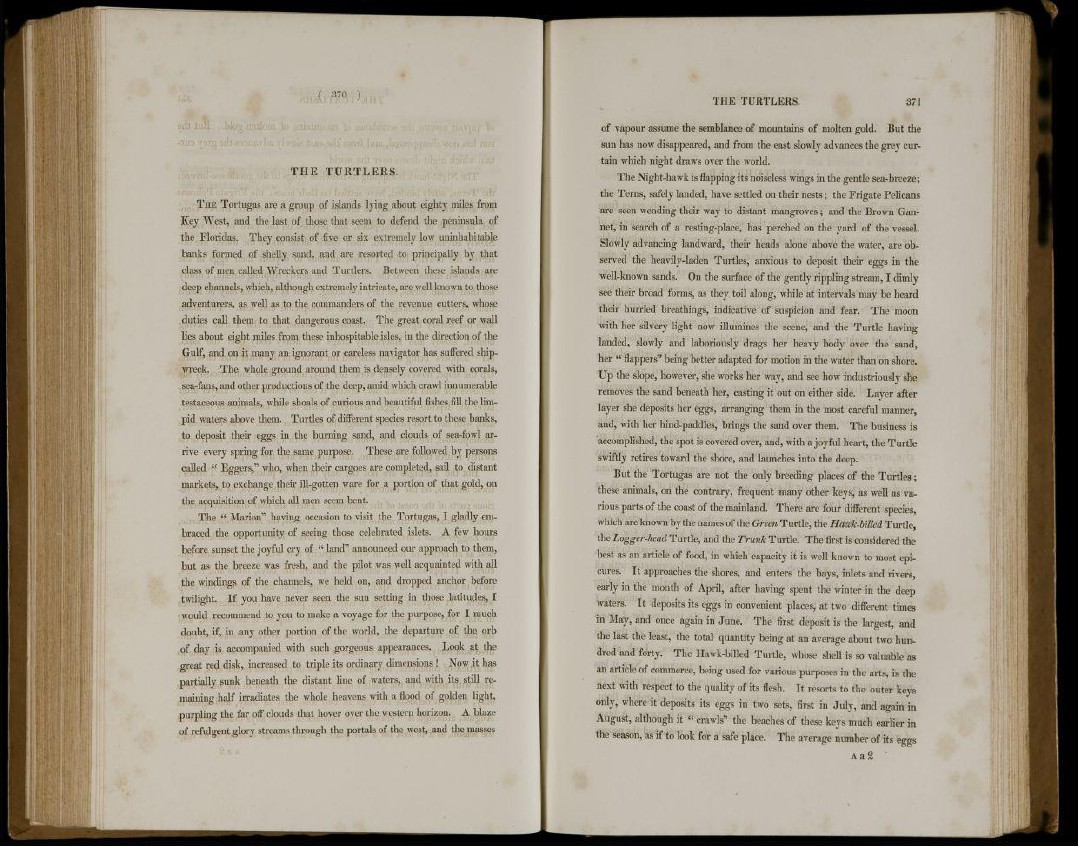
T H E T U R T L E R S .
T H E Tortugas are a group of islands lying about eighty miles from
Key West, and the last of those that seem to defend the peninsula of
the Floridas. They consist of five or six extremely low uninhabitable
banks formed of shelly sand, and are resorted to principally by that
class of men called Wreckers and Turtlers. Between these islands are
deep channels, which, although extremely intricate, are well known to those
adventurers, as well as to the commanders of the revenue cutters, whose
duties call them to that dangerous coast. The great coral reef or wall
lies about eight miles from these inhospitable isles, in the direction of the
Gulf, and on it many an ignorant or careless navigator has suffered shipwreck.
The whole ground around them is densely covered with corals,
sea-fans, and other productions of the deep, amid which crawl innumerable
testaceous animals, while shoals of curious and beautiful fishes fill the limpid
waters above them. Turtles of different species resort to these banks,
to deposit their eggs in the burning sand, and clouds of sea-fowl arrive
every spring for the same purpose. These are followed by persons
called " Eggers,11 who, when their cargoes are completed, sail to distant
markets, to exchange their ill-gotten ware for a portion of that gold, on
the acquisition of which all men seem bent.
The " Marion11 having occasion to visit the Tortugas, I gladly embraced
the opportunity of seeing those celebrated islets. A few hours
before sunset the joyful cry of " land11 announced our approach to them,
but as the breeze was fresh, and the pilot was well acquainted with all
the windings of the channels, we held on, and dropped anchor before
twilight. If you have never seen the sun setting in those latitudes, I
•would recommend to you to make a voyage for the purpose, for I much
doubt, if, in any other portion of the world, the departure of the orb
of day is accompanied with such gorgeous appearances. Look at the
great red disk, increased to triple its ordinary dimensions ! Now it has
partially sunk beneath the distant line of waters, and with its still remaining
half irradiates the whole heavens with a flood of golden light,
purpling the far off clouds that hover over the western horizon. A blaze
of refulgent glory streams through the portals of the west, and the masses
of vapour assume the semblance of mountains of molten gold. But the
sun has now disappeared, and from the east slowly advances the grey curtain
which night draws over the world.
The Night-hawk is flapping its noiseless wings in the gentle sea-breeze;
the Terns, safely landed, have settled on their nests; the Frigate Pelicans
are seen wending their way to distant mangroves; and the Brown Gannet,
in search of a resting-place, has perched on the yard of the vessel.
Slowly advancing landward, their heads alone above the water, are observed
the heavily-laden Turtles, anxious to deposit their eggs in the
well-known sands. On the surface of the gently rippling stream, I dimly
see their broad forms, as they toil along, while at intervals may be heard
their hurried breathings, indicative of suspicion and fear. The moon
with her silvery light now illumines the scene, and the Turtle having
landed, slowly and laboriously drags her heavy body over the sand,
her " flappers1' being better adapted for motion in the water than on shore.
Up the slope, however, she works her way, and see how industriously she
removes the sand beneath her, casting it out on either side. Layer after
layer she deposits her eggs, arranging them in the most careful manner,
and, with her hind-paddles, brings the sand over them. The business is
accomplished, the spot is covered over, and, with a joyful heart, the Turtle
swiftly retires toward the shore, and launches into the deep.
But the Tortugas are not the only breeding places of the Turtles;
these animals, on the contrary, frequent many other keys, as well as various
parts of the coast of the mainland. There are four different species,
which are known by the names of the Green Turtle, the Hawk-billed Turtle,
the Logger-head Turtle, and the Trunk Turtle. The first is considered the
best as an article of food, in which capacity it is well known to most epicures.
It approaches the shores, and enters the bays, inlets and rivers,
early in the month of April, after having spent the winter in the deep
waters. It deposits its eggs in convenient places, at two different times
in May, and once again in June. The first deposit is the largest, and
the last the least, the total quantity being at an average about two hundred
and forty. The Hawk-billed Turtle, whose shell is so valuable as
an article of commerce, being used for various purposes in the arts, is the
next with respect to the quality of its flesh. It resorts to the outer keys
only, where it deposits its eggs in two sets, first in July, and again in
August, although it " crawls11 the beaches of these keys much earlier in
the season, as if to look for a safe place. The average number of its eggs
A a 2 '